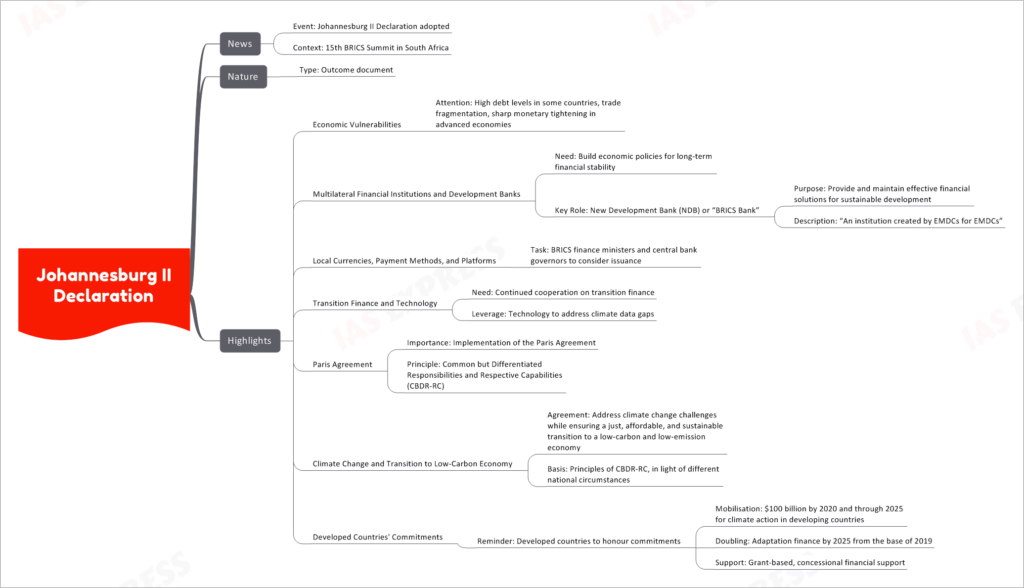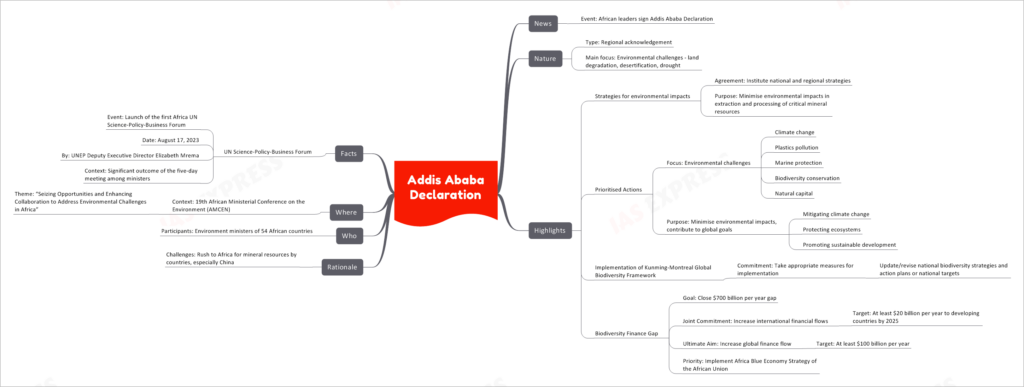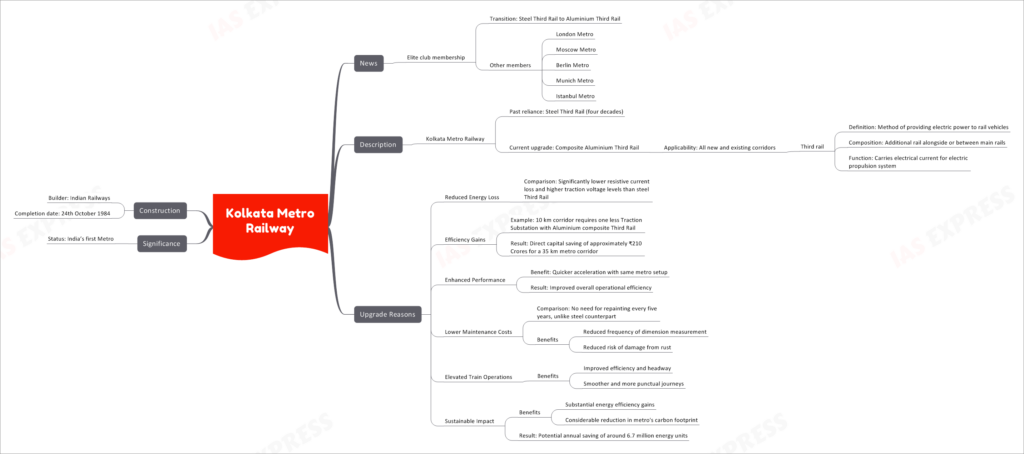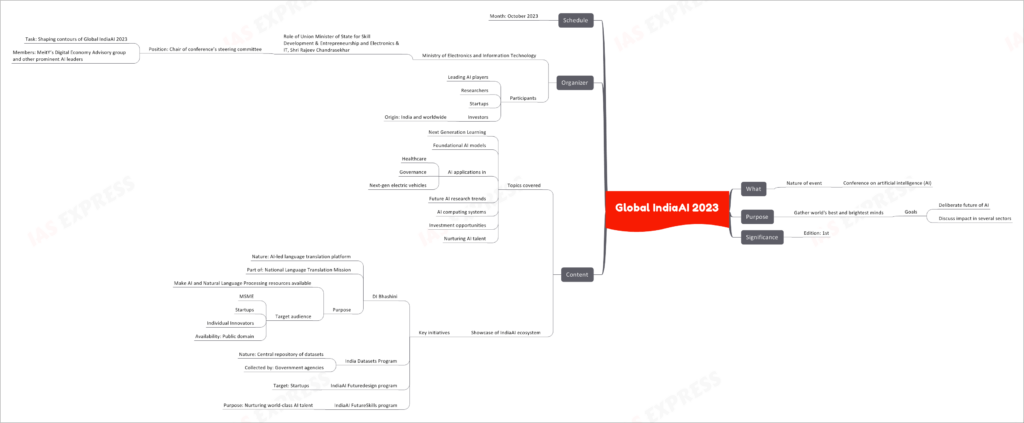[Newsbits] 30.08.2023

Johannesburg II Declaration
The Johannesburg II Declaration has been adopted as a significant outcome document, marking the culmination of the 15th BRICS Summit held in South Africa. This declaration is a testament to the commitment of BRICS nations to collaborative efforts addressing key economic and environmental challenges.
Nature and Context
The Johannesburg II Declaration holds the essence of an outcome document, symbolizing the consensus achieved among BRICS nations during their summit in South Africa.
Key Highlights
Addressing Economic Vulnerabilities
- Focus Areas: The declaration draws attention to economic vulnerabilities stemming from high debt levels in certain countries, trade fragmentation, and sharp monetary tightening in advanced economies.
Enhancing Multilateral Financial Institutions
- Long-Term Stability: The document underscores the need to build economic policies that ensure long-term financial stability.
- Role of New Development Bank (NDB): The New Development Bank, also known as the "BRICS Bank," plays a key role in providing and maintaining effective financial solutions for sustainable development.
- Purpose: The NDB serves as an institution created by Emerging Market and Developing Countries (EMDCs) to support their development needs.
Exploring Local Currencies and Payment Methods
- Task Ahead: BRICS finance ministers and central bank governors are entrusted with considering the issuance of local currencies, payment methods, and platforms to bolster economic cooperation.
Cooperative Transition Finance and Technology
- Continued Cooperation: The declaration emphasizes the importance of ongoing collaboration on transition finance.
- Leveraging Technology: The use of technology is highlighted as a means to address gaps in climate data and facilitate informed decision-making.
Upholding the Paris Agreement
- Importance: The declaration underscores the significance of implementing the Paris Agreement to combat climate change.
- Principle of CBDR-RC: Common but Differentiated Responsibilities and Respective Capabilities (CBDR-RC) remains a guiding principle for collective climate action.
Climate Change and the Path to a Low-Carbon Economy
- Collective Agreement: The declaration reflects the commitment to address climate change challenges while ensuring an equitable, affordable, and sustainable transition to a low-carbon and low-emission economy.
- Principled Approach: The principles of CBDR-RC serve as a foundation, accommodating different national circumstances.
Holding Developed Countries Accountable
- Reminder: The declaration urges developed countries to fulfill their commitments.
- Mobilization: Mobilize $100 billion by 2020 and extend it through 2025 for climate action in developing countries.
- Doubling Adaptation Finance: Commit to doubling adaptation finance by 2025 from the base of 2019.
- Support Mechanism: Developed countries are encouraged to provide grant-based, concessional financial support.
Addis Ababa Declaration
In a monumental event, African leaders came together to sign the Addis Ababa Declaration, marking a pivotal regional acknowledgement of the pressing environmental challenges faced by the continent. This declaration underscores Africa's commitment to address critical issues such as land degradation, desertification, and drought.
Nature and Focus
The Addis Ababa Declaration holds significance as a regional acknowledgement that emphasizes the shared responsibility of African nations in tackling environmental challenges that threaten the continent's well-being.
Key Highlights
Strategies for Minimizing Environmental Impacts
- National and Regional Strategies: The declaration entails an agreement to institute comprehensive national and regional strategies aimed at minimizing environmental impacts during the extraction and processing of critical mineral resources.
Prioritized Actions for Environmental Sustainability
- Focus Areas: The declaration identifies key focus areas for action, including addressing climate change, tackling plastics pollution, marine protection, biodiversity conservation, and safeguarding natural capital.
- Purpose: These actions are aligned with the goal of minimizing environmental impacts while contributing to global objectives such as mitigating climate change, protecting ecosystems, and promoting sustainable development.
Implementation of the Kunming-Montreal Global Biodiversity Framework
- Commitment: The Addis Ababa Declaration commits African nations to take appropriate measures for the effective implementation of the Kunming-Montreal Global Biodiversity Framework.
- Strategy Updates: Nations will update or revise their national biodiversity strategies and action plans, as well as national targets, to align with the framework's objectives.
Bridging the Biodiversity Finance Gap
- Closing the Gap: The declaration sets the ambitious goal of closing the biodiversity finance gap, estimated at $700 billion per year.
- Joint Commitment: African leaders commit to increasing international financial flows, targeting at least $20 billion per year to developing countries by 2025.
- Global Finance Flow: The ultimate aim is to increase global finance flow to a minimum of $100 billion per year.
- Priority: The declaration also underscores the importance of implementing the Africa Blue Economy Strategy of the African Union.
Rationale
- Challenges Addressed: The Addis Ababa Declaration is a response to the challenges posed by the rush for mineral resources in Africa, particularly by countries such as China.
Participants and Venue
- Participants: The declaration was signed by the environment ministers of 54 African countries, collectively demonstrating their commitment to environmental sustainability.
- Venue: The Addis Ababa Declaration was a significant outcome of the 19th African Ministerial Conference on the Environment (AMCEN), held under the theme "Seizing Opportunities and Enhancing Collaboration to Address Environmental Challenges in Africa."
Facts and Outcomes
- UN Science-Policy-Business Forum: The launch of the first Africa UN Science-Policy-Business Forum was a significant outcome of the AMCEN meeting.
- Date: The forum was launched on August 17, 2023, under the leadership of UNEP Deputy Executive Director Elizabeth Mrema.
- Context: The forum's establishment was a direct result of discussions and collaboration during the five-day AMCEN meeting.
General Comment No. 26
In a groundbreaking development, the UN's General Comment No. 26, adopted on August 28th, has emerged as a significant guideline aimed at promoting climate action by states to safeguard the rights of children. This 20-page document is a milestone in the global effort to address the intersection of climate change and children's rights.
Nature and Format
General Comment No. 26 represents a new guidance from the UN, presented in the form of a 20-page document. Its primary focus is to address the urgent need for climate action by states to ensure the protection of children’s rights in the face of climate challenges.
Key Highlights
Addressing Business-Related Harms to Children's Rights
- UN Member States' Responsibility: The guidance calls upon UN member states to take necessary, appropriate, and reasonable measures to address harms to children's rights caused by business-related activities.
Transitioning Away from Fossil Fuels
- Equitable Phasing Out: The document urges nations to equitably phase out coal, oil, and natural gas from their energy mix.
- Additional Requests: It emphasizes the importance of ensuring a fair and just transition of energy sources, along with investments in renewable energy, energy storage, and energy efficiency.
Establishing Inclusive Early Warning Systems
- Priority: The guidance underscores the priority of establishing inclusive early warning systems to shield children from the adverse impacts of extreme weather events.
Bridging Climate Finance Gaps
- Developing Countries' Concern: The guidance raises concerns about climate finance gaps in developing countries.
- Request to Developed Countries: It calls on developed nations to provide grants instead of loans to support climate adaptation efforts.
- Addressing Unequal Share: The guidance highlights the unequal distribution of finances for adaptation and loss and damage measures, which disproportionately affects children in vulnerable areas.
Urging Emissions Reductions
- Nations' Obligation: The document requests nations to prioritize rapid and effective emissions reductions to ensure the full enjoyment of rights for children and to prevent irreversible damage to the environment.
Addressing Climate-Induced Migration and Displacement
- Rights-Based Approach: The guidance emphasizes the need for adaptation frameworks to address climate-induced migration and displacement while upholding child rights.
Significance and Legal Framework
- Unprecedented Nature: General Comment No. 26 holds the distinction of being the first of its kind guidance from the UN, marking a significant milestone in climate action and children’s rights protection.
- Context: This guideline aligns with the UN's declaration that access to a clean and healthy environment is a universal human right.
Legal Framework and Objectives
- Purpose: The General Comment serves to address the adverse effects of environmental degradation and climate change on children’s rights.
- Objective: Its overarching goal is to ensure a clean, healthy, and sustainable world for present and future generations.
- Significance: The document meticulously outlines member states’ obligations under the Child Rights Convention, with specific emphasis on addressing environmental harms and guaranteeing children's rights.
Responsible Body: UN Committee on the Rights of the Child
- Composition: The UN Committee on the Rights of the Child consists of 18 independent experts.
- Functions: It actively monitors the implementation of the Convention on the Rights of the Child and its Optional Protocols, encompassing issues such as the involvement of children in armed conflict, sale of children, child prostitution, and child pornography.
Historical Context: 1989 UN Convention on Rights of the Child
- Outlined Rights: The 1989 UN Convention on the Rights of the Child delineated fundamental rights, including life, health, access to clean drinking water, and survival and development.
- Global Impact: This convention has been ratified by an impressive 196 countries, demonstrating widespread commitment to safeguarding children's rights.
Kolkata Metro Railway
In a significant stride towards technological advancement, the Kolkata Metro Railway has recently joined the elite club of metro networks making the transition from Steel Third Rail to the more innovative and efficient Aluminium Third Rail. This development aligns Kolkata Metro Railway with esteemed counterparts like the London Metro, Moscow Metro, Berlin Metro, Munich Metro, and Istanbul Metro.
Description: Embracing Innovation
The Kolkata Metro Railway, renowned as India's first metro, has historically relied on the Steel Third Rail for over four decades. However, the recent upgrade to the Composite Aluminium Third Rail marks a pivotal transition in powering the metro network.
Composite Aluminium Third Rail: Empowering Progress
The Composite Aluminium Third Rail is a revolutionary method of providing electric power to rail vehicles. It consists of an additional rail alongside or between the main rails, functioning as the conduit for the electric propulsion system.
Upgrade Reasons: A Leap Towards Efficiency
The decision to transition to the Aluminium Third Rail stems from a multitude of compelling reasons, each contributing to the overall enhancement of the metro system.
Reduced Energy Loss: A New Paradigm
- Comparison: The Aluminium Third Rail boasts significantly lower resistive current loss and higher traction voltage levels in comparison to the traditional Steel Third Rail.
Efficiency Gains: Capital and Resource Savings
- Example: A 10 km corridor powered by the Aluminium composite Third Rail requires one less Traction Substation.
- Result: This directly translates to a capital saving of approximately ₹210 Crores for a 35 km metro corridor.
Enhanced Performance: Acceleration Redefined
- Benefit: The Aluminium Third Rail enables quicker acceleration with the same metro setup.
- Result: This improvement leads to an enhanced overall operational efficiency of the metro system.
Lower Maintenance Costs: Practical Benefits
- Comparison: Unlike its steel counterpart, the Aluminium Third Rail doesn't require repainting every five years.
- Benefits: This results in reduced frequency of dimension measurement and lowers the risk of damage from rust.
Elevated Train Operations: Elevating Efficiency
- Benefits: The transition contributes to improved operational efficiency and smoother, punctual journeys for passengers.
Sustainable Impact: Environmentally Friendly
- Benefits: The shift to the Aluminium Third Rail results in substantial energy efficiency gains and a considerable reduction in the metro's carbon footprint.
- Result: The potential annual saving amounts to around 6.7 million energy units.
Significance: A Pioneer's Legacy
The Kolkata Metro Railway holds the distinguished title of being India's first metro, solidifying its significance in the country's transportation history.
Construction: A Remarkable Endeavor
The Kolkata Metro Railway was constructed under the able guidance of Indian Railways and achieved its completion milestone on October 24th, 1984. This monumental project laid the foundation for urban transportation infrastructure in India, setting a benchmark for future endeavors.
Global IndiaAI 2023
In the rapidly evolving landscape of technology, artificial intelligence (AI) stands at the forefront of innovation. The Global IndiaAI 2023 conference serves as a monumental platform to convene some of the brightest minds from around the world, with the overarching goal of deliberating the future of AI and discussing its profound impact across various sectors.
Nature of the Event: Uniting AI Visionaries
The Global IndiaAI 2023 is a distinguished conference dedicated to exploring the vast realm of artificial intelligence.
Purpose: Illuminating AI's Potential
The primary purpose of the conference is to gather the world's leading experts, researchers, and innovators to collectively shape the trajectory of AI's future.
Goals: Fostering Deliberation and Understanding
- Deliberate on the Future: The conference aims to foster in-depth discussions on the future of AI, examining its potential applications and implications.
- Impact Across Sectors: Another pivotal goal is to delve into the far-reaching impact of AI across diverse sectors, unveiling new possibilities and addressing potential challenges.
Significance: The Inaugural Edition
The Global IndiaAI 2023 marks the inaugural edition of this prestigious conference, promising to set the stage for continued exploration and advancement in the realm of artificial intelligence.
Content: A Multifaceted Exploration
The conference promises a rich array of content, touching upon a wide spectrum of topics that are integral to the AI landscape.
Topics Covered: Encompassing AI's Horizons
- Next Generation Learning: Exploring how AI is shaping the future of education and learning methodologies.
- Foundational AI Models: Delving into the core AI models that serve as the building blocks for various applications.
- AI Applications in Various Sectors: Analyzing the role of AI in domains like healthcare, governance, and next-generation electric vehicles.
- Future AI Research Trends: Unveiling the upcoming trends and directions in AI research.
- AI Computing Systems: Understanding the evolving landscape of AI hardware and computing infrastructure.
- Investment Opportunities: Highlighting the potential for investment and growth in the AI sector.
- Nurturing AI Talent: Addressing the critical aspect of nurturing and developing skilled AI professionals.
Showcase of IndiaAI Ecosystem: Highlighting Innovations
- DI Bhashini: A language translation platform driven by AI, forming a part of the National Language Translation Mission. It aims to make AI and Natural Language Processing resources widely accessible to MSMEs, startups, and individual innovators.
- India Datasets Program: A central repository of datasets collected by government agencies, facilitating research and development in the AI field.
- IndiaAI Futuredesign Program: Geared towards startups, this program seeks to foster innovative solutions in AI.
- IndiaAI FutureSkills Program: An initiative aimed at nurturing world-class AI talent to meet the growing demands of the industry.
Organizer: Steering AI Advancements
The Ministry of Electronics and Information Technology (MeitY) takes on the role of organizing and facilitating the Global IndiaAI 2023 conference.
Key Players in Organization:
- Union Minister of State: Shri Rajeev Chandrasekhar, responsible for Skill Development & Entrepreneurship and Electronics & IT, chairs the conference’s steering committee.
- Committee Members: MeitY’s Digital Economy Advisory group and prominent leaders in the AI domain contribute to shaping the contours of the event.
Participants: A Diverse Gathering
The conference anticipates a diverse range of participants, each playing a crucial role in shaping the AI landscape.
- Leading AI Players: Industry giants and experts from renowned organizations will provide insights and expertise.
- Researchers: Academics and researchers contribute cutting-edge research findings.
- Startups: Emerging startups showcase innovative AI applications and solutions.
- Investors: Both from India and around the world, investors scout for promising AI ventures.
Schedule:
The Global IndiaAI 2023 conference is scheduled to take place in the month of October, offering a platform for learning, collaboration, and a shared vision for the future of artificial intelligence.
INS Mahendragiri
In a recent development that showcases India's growing naval prowess, the INS Mahendragiri, a cutting-edge navy warship, has been launched on September 1st. The launch ceremony was graced by Vice President Dhankhar, marking a significant stride in India's maritime capabilities.
Launch Details
- Launch Date: September 1st
- Launched by: Vice President Dhankhar
Definition: The Jewel of Naval Fleet
The INS Mahendragiri is the seventh and final stealth frigate developed as part of Project 17A, a remarkable endeavor by the Indian Navy to enhance its naval fleet.
Project 17A: Building on a Legacy
- Relation to Previous Projects: Project 17A frigates are the successors of the esteemed Project 17 Class Frigates, also known as Shivalik Class.
- Key Improvements: This project introduces advanced stealth features, state-of-the-art weapons and sensors, and cutting-edge platform management systems.
- Stealth Features: The INS Mahendragiri is equipped with enhanced stealth features, allowing it to operate covertly in various maritime scenarios.
- Advanced Weapons and Sensors: The warship boasts a wide array of advanced weaponry and sensors, elevating its combat capabilities.
- Platform Management Systems: The incorporation of advanced platform management systems ensures seamless operations and optimal performance.
Name Origin: A Tribute to the Land
The name "Mahendragiri" draws its inspiration from a majestic mountain peak located in the Eastern Ghats of Orissa.
- Description: Mahendragiri is a notable mountain peak renowned for its scenic beauty and historical significance.
- Location: Situated in the state of Orissa, this mountain peak adds a touch of grandeur to the naval vessel.
Features: A Closer Look
The INS Mahendragiri is brimming with cutting-edge features, enabling it to excel in various naval operations.
Stealth: Operating Unseen
- Improved Stealth Features: The warship's design and technology ensure it can navigate through waters discreetly, reducing its visibility to adversaries.
Weapons and Sensors: A Formidable Arsenal
- Advanced Weaponry: The vessel is armed with advanced weaponry, bolstering its offensive and defensive capabilities.
- Sensors: State-of-the-art sensors provide comprehensive situational awareness, enabling precise decision-making during operations.
Platform Management Systems: Streamlining Operations
- Advanced Systems: The integration of advanced platform management systems optimizes the ship's functionality, from propulsion to communication.
Equipment Origin: Fostering Indigenous Innovation
- Indigenous Firms Contribution: Approximately 75% of the equipment used in the INS Mahendragiri is sourced from indigenous firms.
- Involvement of MSMEs: The Micro, Small, and Medium Enterprises (MSMEs) play a vital role in supplying components, boosting local industries.
- Make in India Initiative: The project aligns with the Make in India initiative, promoting self-sufficiency and domestic production.
Significance: Strategic Timing
The launch of INS Mahendragiri holds significant geopolitical implications, particularly in light of China's ambitions in the Indian Ocean.
- Timing: The warship's introduction aligns with India's strategic efforts to safeguard its interests in the Indian Ocean region.
Design and Development: Crafting Excellence
Behind the INS Mahendragiri's remarkable design and development lies the expertise of Indian Navy's Warship Design Bureau and the craftsmanship of Mazagon Dock Shipbuilders Limited in Mumbai.
- Designed by: Indian Navy's Warship Design Bureau
- Developed at: Mumbai's Mazagon Dock Shipbuilders Limited
- Project 17A Warships Development Locations: Four warships are being developed at Mazagon Dock in Mumbai, while three are under construction at Garden Reach Shipbuilders & Engineers (GRSE) in Kolkata.
Timeline: A Journey of Progress
The INS Mahendragiri is part of the larger Project 17A initiative that spans several years, marked by key milestones.
- Project 17A Ships Launched: The project's ships have been launched over a span from 2019 to 2023.
Recent Developments: Green Signal for Progress
A recent development further underscores the significance of the INS Mahendragiri and its sister vessels.
- President Droupadi Murmu: Gave the green signal for progress.
- Date: August 17
- Subject: President Murmu's approval was for the sixth warship of Project 17A, named Vindhyagiri, currently under construction in Kolkata.
If you like this post, please share your feedback in the comments section below so that we will upload more posts like this.






